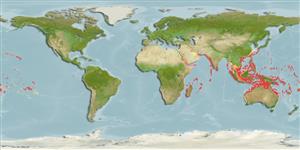Common names from other countries
分類 / Names
俗名 | 同種異名 | Catalog of Fishes(屬, 種) | ITIS | CoL | WoRMS | Cloffa
Teleostei >
Acanthuriformes (Surgeonfishes)
鱸形目 (Surgeonfishes) >
Acanthuridae (Surgeonfishes, tangs, unicornfishes)
刺尾魚科 (Surgeonfishes, tangs, unicornfishes) > Acanthurinae
Etymology: Zebrasoma: Derived from Zebra = African horse + Greek, soma = body; referring to the stripes (Ref. 45335).
More on author: Cuvier.
Environment: milieu / climate zone / depth range / distribution range
生態學
海洋 礁區魚類; 深度上下限 0 - 60 m (Ref. 1602), usually 1 - 60 m (Ref. 27115). 熱帶; 25°C - 28°C (Ref. 27115); 31°N - 34°S, 32°E - 124°W
Indo-Pacific: East Africa, including the Mascarene Islands (Ref. 37792) to the Tuamoto Islands, north to southern Japan, south to Lord Howe and Rapa islands.
印度-太平洋: 東非, 包括瑪斯科林島 (參考文獻 37792) 到 Tuamoto 島, 北至日本南部, 南至羅得豪島與拉帕群島。
大小 / 重量 / 年齡
Maturity: Lm ? range ? - ? cm
Max length : 40.0 cm SL 雄魚/尚未辨別雌雄; (Ref. 48637)
背棘 (總數) : 4 - 5; 背的軟條 (總數) : 23 - 25; 臀棘: 3; 臀鰭軟條: 19 - 21. Dark brown (body in life with fine pale blue-green longitudinal lines following scale rows, becoming dots anteriorly on body and on head) (Ref 9808). Small juveniles have yellowish bars and more prominent yellow specks than adults.
深褐色的 (身體活著時有細的藍灰色-綠色的縱向線在鱗片列之後, 在身體與頭部上前面地成為點)(參考文獻 9808). 小的稚魚超過成魚有淡黃色的橫帶與較突出的黃色斑點。
Occurs in coral-rich areas of lagoon and seaward reefs. Graze on algae, usually in groups of 20 individuals (Ref. 5503, 48637). Adults usually in small groups and sometimes schooling. Juveniles solitary and usually among corals (Ref. 48637). Its numerous, small pharyngeal teeth may have evolved in response to a shift in diet from macroalgae to filamentous algae (Ref. 33204). Form resident spawning aggregations (Ref. 27825). Monogamous (Ref. 52884). Group and pair spawning have been observed. The flesh is never poisonous (Ref. 4795). Minimum depth reported taken from Ref. 128797.
出現於潟湖與臨海礁石的珊瑚礁繁盛區域。 啃食藻類,20個個體通常成群.(參考文獻 5503) 它的很多又小的咽齒回應從大型藻類到菌絲藻的食性的變化可能有進化。 (參考文獻 33204) 形成定居的產卵群集。 (參考文獻 27825) 一夫一妻的.(參考文獻 52884) 群與成對產卵曾經觀察。 肉從不是有毒的。 (參考文獻 4795)
Life cycle and mating behavior
Maturities | 繁殖 | Spawnings | Egg(s) | Fecundities | 仔魚
Form resident spawning aggregations (Ref. 27825). Monogamous mating is observed as both facultative and social (Ref. 52884).印度-太平洋: 東非, 包括瑪斯科林島 (參考文獻 37792) 到 Tuamoto 島, 北至日本南部, 南至羅得豪島與拉帕群島。
Myers, R.F., 1991. Micronesian reef fishes. Second Ed. Coral Graphics, Barrigada, Guam. 298 p. (Ref. 1602)
CITES (Ref. 128078)
Not Evaluated
人類使用
漁業: 商業性; 水族館: 商業性
工具
特別的報告
下載 XML
網路資源
Estimates based on models
Preferred temperature (Ref.
115969): 24.6 - 28.9, mean 27.6 (based on 1646 cells).
Phylogenetic diversity index (Ref.
82804): PD
50 = 0.5078 [Uniqueness, from 0.5 = low to 2.0 = high].
Bayesian length-weight: a=0.02512 (0.02073 - 0.03043), b=2.98 (2.93 - 3.03), in cm Total Length, based on LWR estimates for this species (Ref.
93245).
營養階層 (Ref.
69278): 2.0 ±0.00 se; based on food items.
回復力 (Ref.
120179): 中等的, 族群倍增時間最少 1.4 - 4.4年 (K=0.425; Tmax=33).
Fishing Vulnerability (Ref.
59153): Moderate vulnerability (39 of 100).
